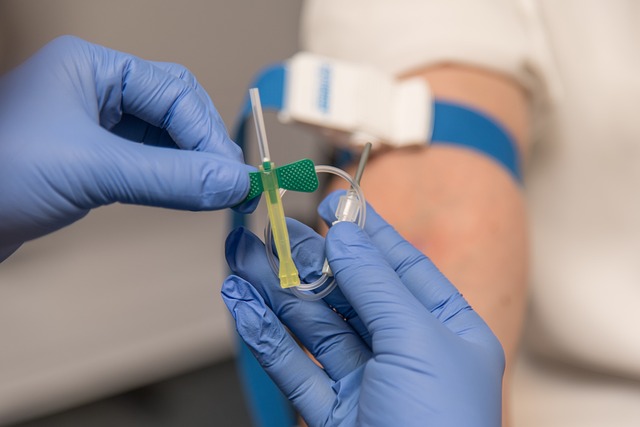Iron deficiency anemia, characterized by fatigue and low hemoglobin levels (below 13.5 g/dL for men), is diagnosed via a Standard Liver Blood Test (SLBT) UK, which assesses liver enzymes (ALT, AST) and blood cells. The SLBT helps determine severity and guides treatment, ranging from dietary changes to medical interventions, with regular follow-up blood tests crucial for monitoring progress.
Iron deficiency anemia is a common yet serious health condition, often caused by inadequate iron intake or blood loss. It can lead to fatigue, weakness, and shortness of breath. This article explores how liver blood tests, including those commonly used in the UK’s standard liver blood test, play a crucial role in diagnosing iron deficiency anemia. We’ll delve into interpreting results and available management options to help identify and address this condition effectively.
- Understanding Iron Deficiency Anemia and Its Impact
- The Role of Liver Blood Tests in Diagnosis
- Interpreting Results and Management Options
Understanding Iron Deficiency Anemia and Its Impact
Iron deficiency anemia is a common blood disorder where your body doesn’t have enough healthy red blood cells to carry adequate oxygen to your whole body. This condition arises when there’s a lack of iron, an essential mineral that plays a vital role in producing hemoglobin, the protein responsible for transporting oxygen in red blood cells. Understanding this type of anemia and its impact is crucial as it can lead to various symptoms such as fatigue, weakness, pale skin, shortness of breath, and dizziness. Left untreated, it may cause more serious complications.
A Standard Liver Blood Test (SLBT) UK, also known as a full blood count (FBC), is one of the primary tools used to diagnose iron deficiency anemia. This test evaluates different components of your blood, including red blood cells, white blood cells, and platelets. By examining the size, shape, and number of red blood cells, healthcare professionals can identify anomalies indicative of anemia. The SLBT provides valuable insights into the severity of the condition and guides appropriate treatment options, such as dietary changes, iron supplements, or in more severe cases, medical interventions to restore iron levels and overall health.
The Role of Liver Blood Tests in Diagnosis
In addition to standard liver blood tests in the UK, which assess key enzymes and levels like alanine aminotransferase (ALT), aspartate aminotransferase (AST), and alkaline phosphatase (ALP), these examinations play a crucial role in diagnosing iron deficiency anemia. An abnormality in these results can indicate underlying liver issues that may contribute to or be indicative of the anemia itself. For instance, elevated levels of ALT and AST could suggest liver damage or inflammation, which is sometimes associated with iron deficiency.
Liver blood tests are valuable because they can uncover potential complications from anemia that might not be evident through other means. They help healthcare professionals understand the comprehensive health status of a patient, including their liver function, which is essential as the liver plays a vital role in iron metabolism and storage within the body.
Interpreting Results and Management Options
Interpreting results is a crucial step after undergoing an Iron Deficiency Anemia (IDA) testing through a Standard Liver Blood Test in the UK. If anaemia is detected, the degree of IDA will be determined by the level of haemoglobin and haematocrit present in your blood. Haemoglobin levels below 13.5 g/dL in men and 12.0 g/dL in women are indicative of anaemia. Haematocrit values below 37% also suggest anaemia. These results, alongside other test outcomes like ferritin levels (a marker for iron stores), can paint a clear picture of your condition.
Management options vary depending on the severity of IDA and individual health status. Treatment typically involves addressing the underlying cause and replacing lost iron. This may include dietary changes to increase iron intake, oral iron supplements, or in more severe cases, intravenous iron therapy. Regular follow-up blood tests are essential to monitor haemoglobin levels and assess the effectiveness of treatment.
Iron deficiency anemia, a common yet potentially serious condition, can be effectively diagnosed and managed through standardized liver blood tests available in the UK. By understanding the role of these tests and interpreting results accurately, healthcare professionals can offer appropriate treatment options to alleviate symptoms and prevent further complications. This approach ensures patients receive timely care, improving overall health outcomes.
